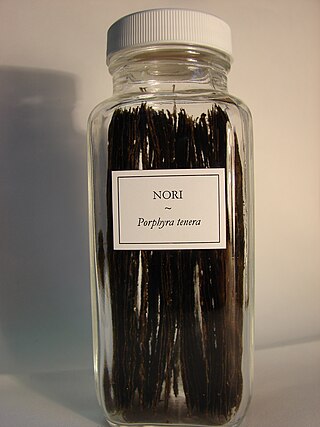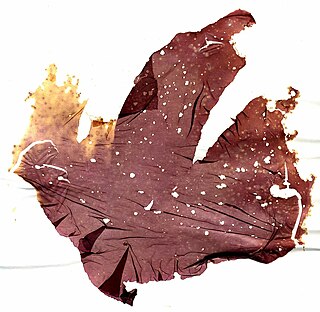
The Chlorophyceae are one of the classes of green algae, distinguished mainly on the basis of ultrastructural morphology. They are usually green due to the dominance of pigments chlorophyll a and chlorophyll b. The chloroplast may be discoid, plate-like, reticulate, cup-shaped, spiral- or ribbon-shaped in different species. Most of the members have one or more storage bodies called pyrenoids located in the chloroplast. Pyrenoids contain protein besides starch. Some green algae may store food in the form of oil droplets. They usually have a cell wall made up of an inner layer of cellulose and outer layer of pectose.

The glaucophytes, also known as glaucocystophytes or glaucocystids, are a small group of unicellular algae found in freshwater and moist terrestrial environments, less common today than they were during the Proterozoic. The stated number of species in the group varies from about 14 to 26. Together with the red algae (Rhodophyta) and the green algae plus land plants, they form the Archaeplastida.

Laminaria is a genus of brown seaweed in the order Laminariales (kelp), comprising 31 species native to the north Atlantic and northern Pacific Oceans. This economically important genus is characterized by long, leathery laminae and relatively large size. Some species are called Devil's apron, due to their shape, or sea colander, due to the perforations present on the lamina. Others are referred to as tangle. Laminaria form a habitat for many fish and invertebrates.

Porphyra is a genus of coldwater seaweeds that grow in cold, shallow seawater. More specifically, it belongs to red algae phylum of laver species, comprising approximately 70 species. It grows in the intertidal zone, typically between the upper intertidal zone and the splash zone in cold waters of temperate oceans. In East Asia, it is used to produce the sea vegetable products nori and gim. There are considered to be 60 to 70 species of Porphyra worldwide and seven around Britain and Ireland where it has been traditionally used to produce edible sea vegetables on the Irish Sea coast. The species Porphyra purpurea has one of the largest plastid genomes known, with 251 genes.

AlgaeBase is a global species database of information on all groups of algae, both marine and freshwater, as well as sea-grass.

Caulerpa lentillifera is a species of ulvophyte green algae from coastal regions in the Asia-Pacific. This seaweed is one of the favored species of edible Caulerpa due to its soft and succulent texture. It is traditionally eaten in the cuisines of Southeast Asia, Oceania, and East Asia. It was first commercially cultivated in the Philippines in the 1950s, followed by Japan in 1968. Both countries remain the top consumers of C. lentillifera. Its cultivation has since spread to other countries, including Vietnam, Taiwan, and China. C. lentillifera, along with C. racemosa, are also known as sea grapes or green caviar in English.

Seaweed, or macroalgae, refers to thousands of species of macroscopic, multicellular, marine algae. The term includes some types of Rhodophyta (red), Phaeophyta (brown) and Chlorophyta (green) macroalgae. Seaweed species such as kelps provide essential nursery habitat for fisheries and other marine species and thus protect food sources; other species, such as planktonic algae, play a vital role in capturing carbon, producing at least 50% of Earth's oxygen.

Saccharina japonica is a marine species of the Phaeophyceae class, a type of kelp or seaweed, which is extensively cultivated on ropes between the seas of China, Japan and Korea. It has the common name sweet kelp. It is widely eaten in East Asia. A commercially important species, S. japonica is also called ma-konbu (真昆布) in Japanese, dasima (다시마) in Korean and hǎidài (海带) in Chinese. Large harvests are produced by rope cultivation which is a simple method of growing seaweeds by attaching them to floating ropes in the ocean.

Red algae, or Rhodophyta, are one of the oldest groups of eukaryotic algae. The Rhodophyta comprises one of the largest phyla of algae, containing over 7,000 currently recognized species with taxonomic revisions ongoing. The majority of species (6,793) are found in the Florideophyceae (class), and mostly consist of multicellular, marine algae, including many notable seaweeds. Red algae are abundant in marine habitats but relatively rare in freshwaters. Approximately 5% of red algae species occur in freshwater environments, with greater concentrations found in warmer areas. Except for two coastal cave dwelling species in the asexual class Cyanidiophyceae, there are no terrestrial species, which may be due to an evolutionary bottleneck in which the last common ancestor lost about 25% of its core genes and much of its evolutionary plasticity.

South Korea is a major center of aquaculture production, and the world's third largest producer of farmed algae as of 2020.

Pyropia tenera, also known as gim or nori, is a red algal species in the genus Pyropia. The specific name, tenera, means "delicate" and alludes to its small size. It typically grows to lengths between 20 and 50 cm. It is most typically found in the western Pacific Ocean and the Indian Ocean.

Porphyra purpurea is a medium sized marine algae in the Division Rhodophyta.

Mastocarpus papillatus, sometimes called Turkish washcloth, black tar spot, or grapestone is a species of red algae in the family Phyllophoraceae. It is sometimes confused with the distantly related Turkish towel which is of a similar texture but larger. The specific epithet papillatus is due to the nipple-like projections on the female gametophyte which can give the texture of a terrycloth washcloth found at a Turkish bath.
Pythium porphyrae, is a parasitic species of oomycete in the family Pythiaceae. It is the cause of red rot disease or red wasting disease, also called akagusare (赤ぐされ) in Japanese. The specific epithet porphyrae (πορφυρα) stems from the genus of one of its common hosts, Porphyra, and the purple-red color of the lesions on the thallus of the host. However, many of its hosts have been moved from the genus Porphyra to Pyropia.

Chondracanthus exasperatus, commonly called Turkish towel, is a species of seaweed in the family Gigartinaceae. The specific epithet exasperatus refers to the bumpy texture of the blades. This texture also leads to the common name which evokes the luxurious feel of a towel from a Turkish bath. The rough, papillae-strewn blade surface even makes it difficult to measure the temperature using infrared thermometers.

Bangiaceae is a family of red algae in the order Bangiales. It contains laver, used to make laverbread, and various species in the genus of Pyropia are used to make nori.














